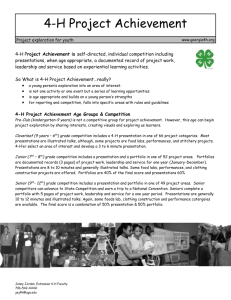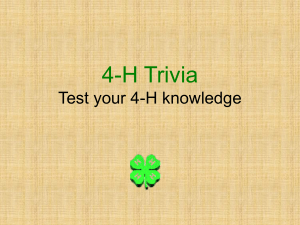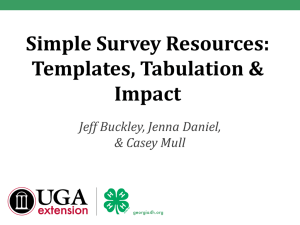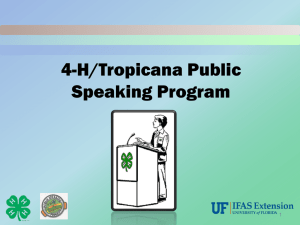Presentation Education - Solano County UC Cooperative Extension
advertisement
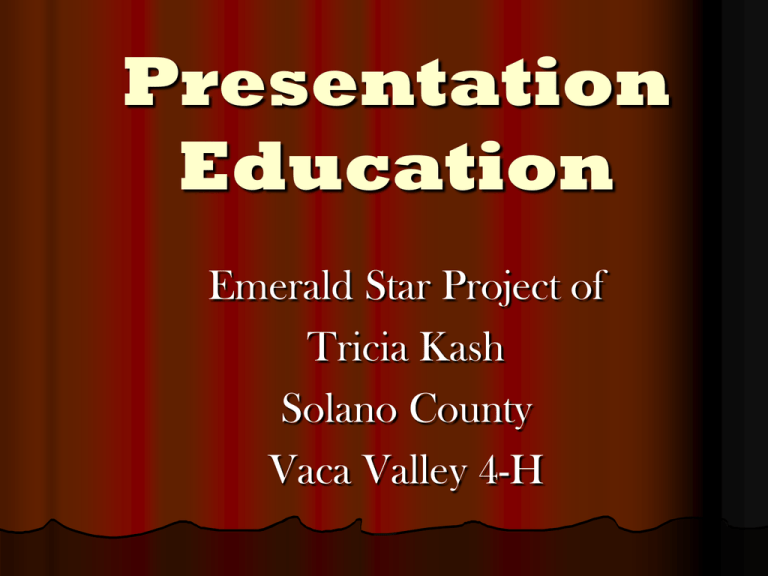
Presentation Education Emerald Star Project of Tricia Kash Solano County Vaca Valley 4-H Overview You will be learning… What is a Presentation? Importance of Public Speaking 4-H and Presentations Basics of Presenting Creative Thinking Types of 4-H Presentations Steps in Choosing Your Presentation Making Your Presentation The Big Show Day Helpful Hints References What is a Presentation? A presentation is a method used to communicate an idea by showing and/or telling. You can use props, posters, and other visual aids. A 4-H presentation helps you learn how to: Research a subject Organize ideas in a logical order Be a teacher Improve public speaking skills Importance of Public Speaking Ranked number one among the skills to have You collect information and ideas Teaching others Builds confidence Help develop life skills Help you be more comfortable during interviews A presentation in front of your peers 4-H and Presentations Presentations are required to earn star ranks Presentations can earn you proficiency awards Basics of Presenting Body Positioning & Body Language Stand slightly to the side of your visual aid Eye contact is important, therefore maintain eye contact as much as possible No slouching! Don’t turn your back to the audience We want to see your hands Distribute your weight Don’t sway! Proper gesturing Good Body Language Stand tall All smiles and positive attitude! Poor Body Language Hide the Frustration Don’t Lose Focus Hand Gestures Don’t be afraid to use your hands! Keep your hands out of your pockets! Show off your work, don’t hide it. Voice Variation Volume of speech should match room Not too loud, but not too soft Keep their attention Project your voice! Prepare for pauses in the speech Creative Thinking Lettering Easy to read words. Limit the CAPITAL letters Fancy lettering or a dramatic change in font Say more, read less Is your visual clear or cluttered? 1. 2. 3. 4. 5. 6. Visibility Simple Interesting Useful Structure Information Colors! Colors! •Background or emphasizing color? •Use complementing colors •Time to be dull? Or time to be bright? Bright against Dark Dark against Bright Types of 4-H Presentations Demonstration Educational Display Interpretive Reading Share the Fun Illustrated Talk Scientific Demonstration Prepared Speech Impromptu Speech Audio-Visual Presentations Cultural Arts Problem Solving Presentations Demonstration “Show how” method Posters or visual aids as enhancements Range 3 to 15 minutes Identifiable sections Connect it to 4-H, not school No notes! Example of Demonstration Board Introduction List of Equipment Procedure Steps You Take Facts are Fun! Visual Aids Educational Display Organized visual presentation Limited Time Individual Project Speaker should be prepared Use time wisely 4 feet reading distance Do not read off your visual aids Card Table Display “It’s Showtime!” Visual Aids Interpretative Reading Any published written work Should know about the reading selection Individual presentation Should have the reading material present, but nothing else. No longer than 5 minutes Give mental picture Share the Fun Group performances only No notes! Dress up?... Of Course!!! No longer than 15 minutes Everything should be understandable Choosing and Creating a Perfect Presentation What is the subject? Research your topic How will you present your presentation? Develop your presentation Prepare your presentation Practice Step 1: What is the subject? Something that you are interested in You are comfortable with this topic Narrow it down Step 2: Research your topic Research, research, research Accurate information with sources Research based sources Step 3: How will you present your presentation? State your purpose Write out your title Organize your points into an outline Introduction Problem Solution Body Conclusion Closing Example of an Outline Introduction: Create interest in your topic. Problem: People do not know how to identify poisonous plants. Solution: Teach people how to identify poisonous plants. Body: Three most common poisonous plants are… 1. Poison Oak 2. Stinging Nettle 3. Poison Ivy Conclusion: “Three common poisonous plants are…” Closing: Is an attention getter Summarizes your purpose Is short and to the point Example: “Look, but don’t touch” Step 4: Develop your presentation Your presentation should be: Focused on one topic An interesting subject Easy to understand Step 5: Prepare your presentation Illustrate your main point Use an outline Use models Step 6: Practice Practice, practice, practice Anticipate questions Try not to memorize your speech Catchy Title Planting plants that use less water to survive. Title Example: “Water you waiting for”? Teaching the Barrel Racing Pattern Title Example: “Turn ‘n’ Burn” The three most common poisonous plants. Title Example: ”Leaf these plants alone!” The Big Show Day Go for the GOLD! •Practice, practice, practice!!! •Eat breakfast •Be presentable •Double check •Arrive early Helpful Hints •Questions and answers Example: Judge – “Why did you choose this topic?” Presenter – “The question was, Why did I choose this topic? I chose this topic because…” •Prepare ahead for food presentations •Cover brand names References Community & Project Leaders State 4-H Presentation Manual http://www.ca4h.org/leadership/spd/

